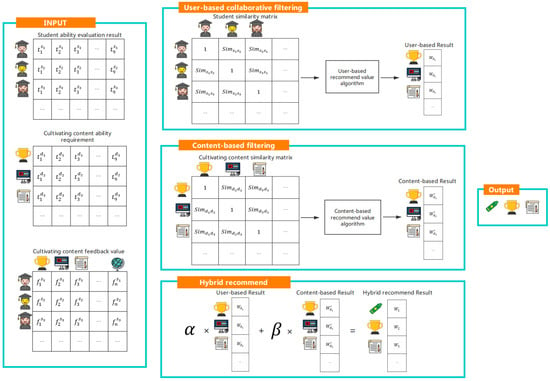Improving the Professional Level of Managers Through Individualized Recommendation to Enhance the Quality of Air Pollutant Management in China
Abstract
:1. Introduction
- (1)
- Aiming to accurately recommend talent for each person from numerous data, MLP-DNN classification information, user-based information, and content-based information are integrated to generate individualized recommendations, which accurately and efficiently learn abilities about different kinds of individuals. Moreover, by analyzing students’ first-view data, we can more objectively identify their talents and reduce the influence of subjective factors, which would provide considerable help for air pollutant management level improvement.
- (2)
- Faced with the chaotic and irregular mass of survey data, a multidimensional ability evaluation model is proposed to acquire the abilities and talents of different people in different aspects. It formulates targeted countermeasures for improving the level of managers by finding people with talent in the field of air pollutant management.
- (3)
- Both user-based and content-based information are taken as important information. They are combined in a hybrid way to recommend suitable and sustainable potential managers for air pollutant management.
- Ability assessment strategy: A set of methods is used to evaluate students’ daily performance for all abilities. It is composed of an experience-oriented set, result-oriented set, and bonus rule. More specifically, the ability assessment strategy has the following characteristics. (1) It has a clear view of the items that can be regarded as bonus items. (2) It gives an absolute credit value that can be precisely calculated.
- Cultivating type: This refers to the method in which the students are recommended to progress during their undergraduate education; for instance, “academic type” is aimed at cultivating students to become academic talents, and “design type” aims to cultivate students to become design talents.
- Cultivating content: The activities or competitions that students have to experience for educational reasons, such as reading books, doing homework, watching courses online, and participating in competitions.
- Experience-based ability growth: This refers to activities in which students participate to improve a certain aspect of their abilities [40,41]. This paper refers to the set of activities that meet the conditions as the experience-oriented set, which is denoted by , where , and indicates activity. Any corresponds to a bonus , and the bonus rule for experience-based ability growth is represented by , where .
- Results-based ability growth: This refers to a student’s participation in a competition to certify a certain ability. In this paper, the set of competitions that meet the conditions is called the results-oriented set, which is denoted by , where , and denotes the competition. Any corresponds to a bonus point and the bonus rule for results-based ability growth is represented by , where .
2. Methods
2.1. Evaluation Model
2.2. MLP-DNN Classifier
2.3. Recommendation
3. Results and Discussion
3.1. Dataset
3.2. Evaluation
3.3. MLP-DNN
3.4. Recommendation
4. Conclusions
Author Contributions
Funding
Acknowledgments
Conflicts of Interest
References
- Huang, J.; Li, F.; Zeng, G.; Liu, W.; Huang, X.; Xiao, Z.; Wu, H.; Gu, Y.; Li, X.; He, X.; et al. Integrating hierarchical bioavailability and population distribution into potential eco-risk assessment of heavy metals in road dust: A case study in Xiandao District, Changsha city, China. Sci. Total Environ. 2016, 541, 969–976. [Google Scholar] [CrossRef] [PubMed]
- Zeng, J.; Liu, Y.; Feiock, R.; Li, F. The impacts of China’s provincial energy policies on major air pollutants: A spatial econometric analysis. Energy Policy 2019, 132, 392–403. [Google Scholar] [CrossRef]
- Peng, S.; Degen, L.; Chen, Q. Study on Air Pollution and Control Investment from the Perspective of the Environmental Theory Model: A Case Study in China, 2005–2014. Sustainability 2018, 10, 2181. [Google Scholar]
- Ashbaugh, L.L. A statistical trajectory technique for determining air pollution source regions. J. Air Pollut. Control Assoc. 1983, 33, 1096–1098. [Google Scholar] [CrossRef]
- Azimi, M.; Feng, F.; Yang, Y. Air pollution inequality and its sources in SO2 and NOx emissions among Chinese provinces from 2006 to 2015. Sustainability 2018, 10, 367. [Google Scholar] [CrossRef]
- Qiu, L.; He, L. Are Chinese green transport policies effective? A new perspective from direct pollution rebound effect, and empirical evidence from the road transport sector. Sustainability 2017, 9, 429. [Google Scholar] [CrossRef]
- Zhang, X.; Wang, Y.; Niu, T.; Zhang, X.; Gong, S.; Zhang, Y.; Sun, J. Atmospheric aerosol compositions in China: Spatial/temporal variability, chemical signature, regional haze distribution and comparisons with global aerosols. Atmos. Chem. Phys. 2012, 12, 779–799. [Google Scholar] [CrossRef]
- Li, R.; Cui, L.; Li, J.; Zhao, A.; Fu, H.; Wu, Y.; Zhang, L.; Kong, L.; Chen, J. Spatial and temporal variation of particulate matter and gaseous pollutants in China during 2014–2016. Atmos. Environ. 2017, 161, 235–246. [Google Scholar] [CrossRef]
- Xie, R.; Zhao, G.; Zhu, B.Z.; Chevallier, J. Examining the factors affecting air pollution emission growth in China. Environ. Model. Assess. 2018, 23, 389–400. [Google Scholar] [CrossRef]
- Cong, X. Air pollution from industrial waste gas emissions is associated with cancer incidences in Shanghai, China. Environ. Sci. Pollut. Res. 2018, 25, 13067–13078. [Google Scholar] [CrossRef]
- Kuo, C.; Pan, R.-H.; Chan, C.-K.; Wu, C.-Y.; Phan, D.-V.; Chan, C.-L. Application of a time-stratified case-crossover design to explore the effects of air pollution and season on childhood asthma hospitalization in cities of differing urban patterns: Big data analytics of government open data. Int. J. Environ. Res. Public Health 2018, 15, 647. [Google Scholar] [CrossRef] [PubMed]
- Wang, M.; Zheng, S.; Nie, Y.; Weng, J.; Cheng, N.; Hu, X.; Ren, X.; Pei, H.; Bai, Y. Association between short-term exposure to air pollution and dyslipidemias among type 2 diabetic patients in northwest China: A population-based study. Int. J. Environ. Res. Public Health 2018, 15, 631. [Google Scholar] [CrossRef] [PubMed]
- Martinez, G.S.; Spadaro, J.V.; Chapizanis, D.; Kendrovski, V.; Kochubovski, M.; Mudu, P. Health impacts and economic costs of air pollution in the metropolitan area of skopje. Int. J. Environ. Res. Public Health 2018, 15, 626. [Google Scholar] [CrossRef] [PubMed]
- Cui, L.; Liu, X.; Geng, X.; Zhou, J.; Li, T. Effects of PM2.5 and haze event on hospital visiting of children in Ji’nan, 2013: A time series analysis. J. Environ. Health 2014, 6, 6. [Google Scholar]
- Zhang, J.; Liu, X. Influence of a severe dust storm on Chinese cities air quality. J. Desert Res. 2008, 28, 9. [Google Scholar]
- Ren, Y.; Shi, J.; Zhu, B.; Zhou, T. An analysis of weather condition during a continuous air pollution process in Nanjing city. Environ. Monit. Forewarn. 2012, 1, 004. [Google Scholar]
- Hu, J.; Wang, Y.; Ying, Q.; Zhang, H. Spatial and temporal variability of PM2.5 and PM10 over the North China plain and the Yangtze river delta, China. Atmos. Environ. 2014, 95, 598–609. [Google Scholar] [CrossRef]
- Zhang, Y.; Liu, Z.; Lv, X.; Zhang, Y.; Qian, J. Characteristics of the transport of a typical pollution event in the Cengdu area based on remote sensing data and numerical simulations. Atmosphere 2016, 7, 127. [Google Scholar] [CrossRef]
- Wang, L.K.; Pereira, N.C.; Hung, Y.-T. Air Pollution Control Engineering; Springer: New York, NJ, USA, 2004; Volume 1, pp. 1–57. [Google Scholar]
- Zundel, T.; Rentz, O.; Dorn, R.; Jattke, A.; Wietschel, M. Control techniques and strategies for regional air pollution control from energy and industrial sectors. Water Air Soil Pollut. 1995, 85, 213–224. [Google Scholar] [CrossRef]
- Lakhani, H. Air pollution control by economic incentives in the US Policy, problems, and progress. Environ. Manag. 1982, 6, 9–20. [Google Scholar] [CrossRef]
- Hao, J.; He, K.; Duan, L.; Li, J.; Wang, L. Air pollution and its control in China. Front. Environ. Sci. Eng. China 2007, 1, 129–142. [Google Scholar] [CrossRef]
- Zhang, L.; Chen, C.; Murlis, J. Study on winter air pollution control in Lanzhou, China. Water Air Soil Pollut. 2001, 127, 351–372. [Google Scholar] [CrossRef]
- Borghi, F.; Spinazzè, A.; Rovelli, S.; Campagnolo, D.; Del Buono, L.; Cattaneo, A.; Cavallo, D.M. Miniaturized monitors for assessment of exposure to air pollutants: A review. Int. J. Environ. Res. Public Health 2017, 14, 909. [Google Scholar] [CrossRef] [PubMed]
- Li, B.; Luo, Y. Enrollment in colleges and universities: A mode of promotion for elite education. Univ. Educ. Sci. 2012, 5, 11–16. [Google Scholar]
- Gao, Q.; Li, C.; Zhang, J. Discussion on Several Issues of Promoting the Enrollment Reform of Colleges and Universities; University Education: Nanning, China, 2018; Volume 12, pp. 17–19. [Google Scholar]
- Tang, S. Analysis of Advantages and Disadvantages of Implementing Large Class Enrollment in Colleges; China Higher Education Research: Beijing, China, 2009; Volume 1, p. 133. [Google Scholar]
- Tang, J. The Trend of Undergraduate Teaching Reform and Construction Practice in China’s First-Class Universities; China Higher Education Research: Beijing, China, 2016; Volume 7, pp. 1–6. [Google Scholar]
- Zhou, Y.; Zhang, W.; Chen, X.; Peng, J. Student Management Model under the Large-Scale Enrollment System; Research in Higher Education of Engineering: Wuhan, China, 2007; Volume 1, pp. 87–89. [Google Scholar]
- Yin, H.; Qi, Q.; Yu, S.; Fan, C. Reform and Practice of Multidisciplinary Interdisciplinary Talents Training under the Mode of Computer and Information Enrollment; Computer Education: Beijing, China, 2014; Volume 7, pp. 10–14. [Google Scholar]
- Liu, Z.; Liu, Z. Exploring the Training Mode of Electronic Information Talents under the Background of Enrollment; Education Teaching Forum: Shijiazhuang, China, 2017; Volume 1, pp. 168–169. [Google Scholar]
- Jiang, Y. Research on the Optimization of the Training Mode of College Enrollment Talents from the Perspective of AMO; University Education: Nanning, China, 2018; Volume 4, pp. 125–127. [Google Scholar]
- Xiong, X.; Li, R.; Li, N. Investigation and Analysis of Undergraduate Enrollment Training Mode; Contemporary Educational Research and Teaching Practice: Shijiazhuang, China, 2018; Volume 7, pp. 209–210. [Google Scholar]
- Dong, C.; Dai, M.; He, L. Research on the Training Mode of Computer Professionals Based on Engineering Education Certification; Education Teaching Forum: Shijiazhuang, China, 2019; Volume 12, pp. 65–66. [Google Scholar]
- Liu, D. Research on the Cultivation Mode of Undergraduates’ Innovation Ability in Computer Science; Computer Education: Beijing, China, 2019; Volume 3, pp. 62–65. [Google Scholar]
- Zhang, X.; Wang, S. Comprehensively Reforming Experimental Teaching, Cultivating Students’ Innovative Ability. Ph.D. Thesis, Nanjing University of Posts and Telecommunications, Nanjing, China, 2005. [Google Scholar]
- Li, L. Research on the Cultivation of Innovative Practice Ability of Undergraduate Students Majoring in Information Management from the Perspective of New Engineering; Research on Library Science: Changchun, China, 2019; Volume 3, pp. 18–23. [Google Scholar]
- Sun, G.; Feng, Y.; Yu, H. Research on Undergraduate Ability Evaluation Method Based on Principal Component Analysis; Software Engineering: Dalian, China, 2019; Volume 3, pp. 9–11. [Google Scholar]
- Jiang, Q.; Cheng, L. Application Research of Dynamic Evaluation Theory in the Evaluation of Students’ Learning Ability. J. Curr. Instr. 2018, 10, 20–23. [Google Scholar]
- Guang, L.; Na, C. Research on the independent cooperative learning mode of students based on computer based courses. China CIO News 2014, 11, 148–149. [Google Scholar]
- Yang, D.; Shen, Y. With a Lifelong Development as a Comprehensive Quality Evaluation System that Leads to the Diversification of Construction Indicators; Tibet Education: Lhasa, China, 2016; Volume 4, pp. 17–19. [Google Scholar]
- Liu, B. Construction of mathematical model and evaluation system for college students’ comprehensive quality evaluation system. J. Taishan Univ. 2015, 6, 54–56. [Google Scholar]
- Yuan, X.; Wang, X. Exploration of the Evaluation Method for the Achievement of Graduation Ability of Computer Students Based on Engineering Certification Standards; Think Tank Era: Taiyuan, China, 2019; Volume 3, pp. 211–213. [Google Scholar]
- Park, J.G.; Jo, S. Approximate bayesian mlp regularization for regression in the presence of noise. Neural Netw. 2016, 83, 75–85. [Google Scholar] [CrossRef]
- Liu, T.; Qiu, T.; Luan, S. Hyperbolic-Tangentfunction-Based Cyclic Correlation: Definition and Theory. Signal Process 2019, 164, 206–216. [Google Scholar] [CrossRef]
- Cao, Q.D.; Choe, Y. Cross-entropy based importance sampling for stochastic simulation models. Reliab. Eng. Syst. Saf. 2019, 191, 106526. [Google Scholar] [CrossRef] [Green Version]
- Fei, Y.; Rong, G.; Wang, B.; Wang, W. Parallel l-bfgs-b algorithm on gpu. Comput. Graph. 2014, 40, 1–9. [Google Scholar] [CrossRef]
- Waltner, E.M.; Rieß, W.; Mischo, C. Development and Validation of an Instrument for Measuring Student Sustainability Competencies. Sustainability 2019, 11, 1717. [Google Scholar] [CrossRef]
- Zhang, C.; Wu, X.; Shyu, M.L.; Peng, Q. Integration of visual temporal information and textual distribution information for news web video event mining. IEEE Trans. Hum.-Mach. Syst. 2015, 46, 124–135. [Google Scholar] [CrossRef]
- De Myttenaere, A.; Golden, B.; Le Grand, B.; Rossi, F. Mean absolute percentage error for regression models. Neurocomputing 2016, 192, 38–48. [Google Scholar] [CrossRef]
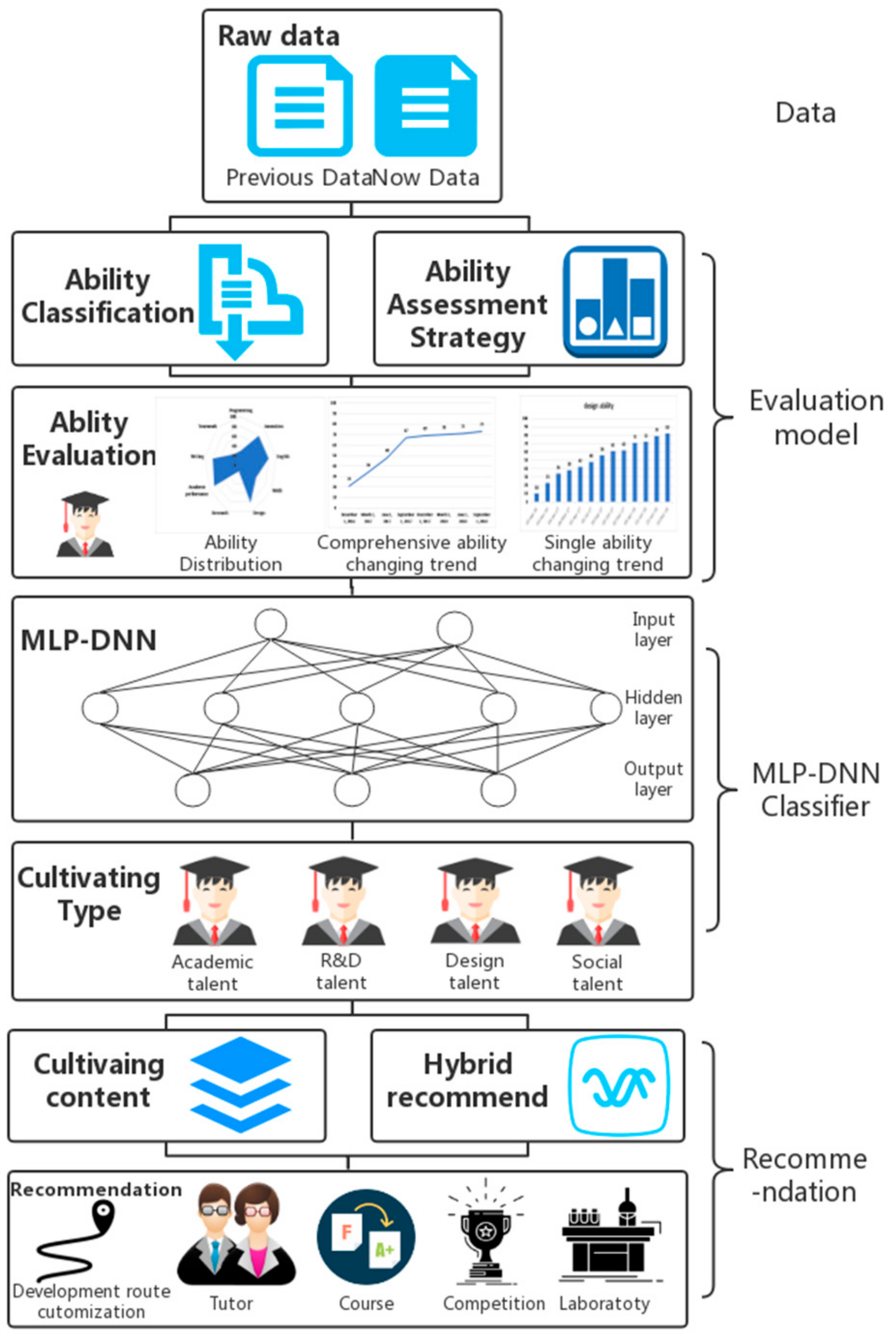
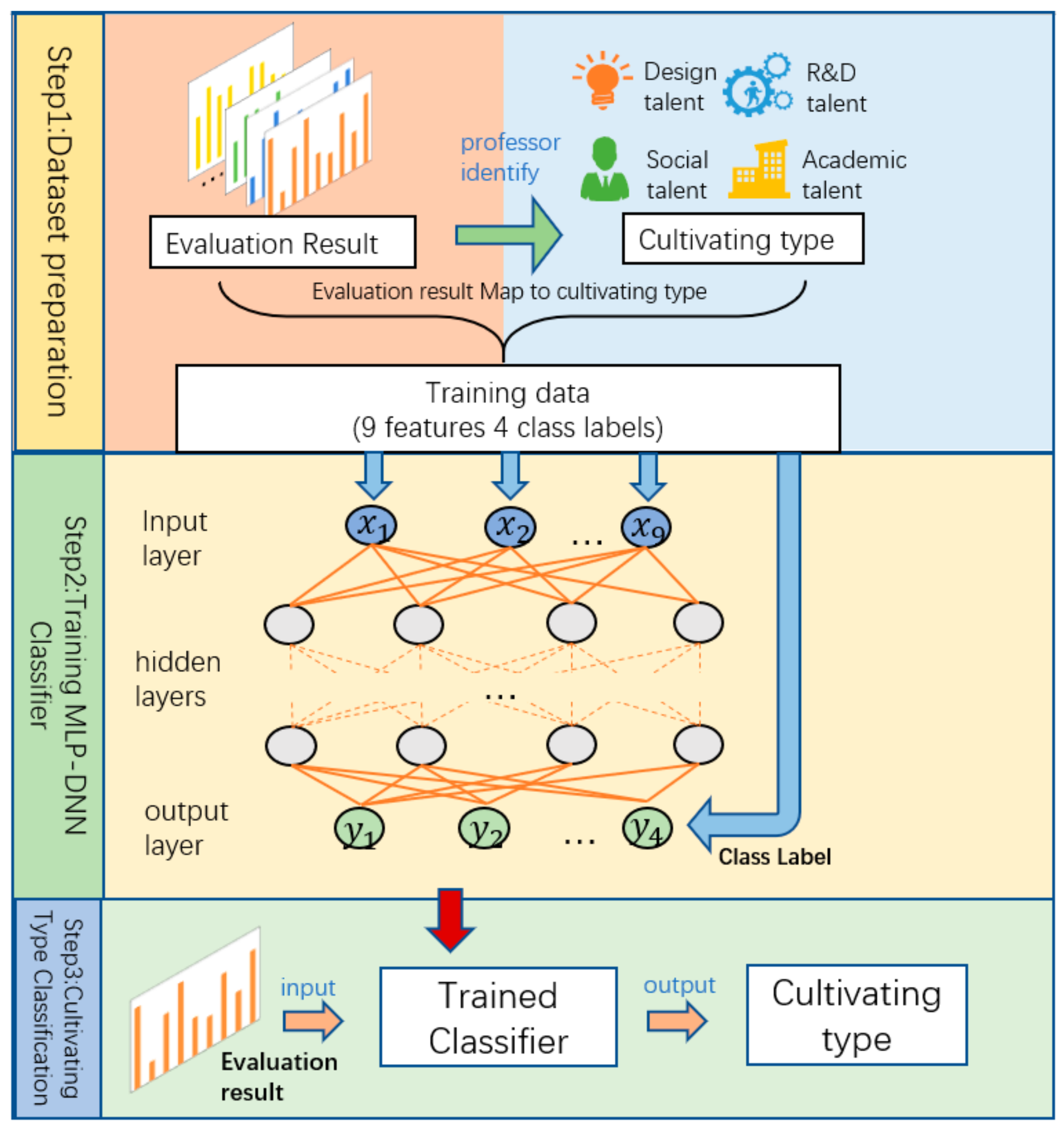
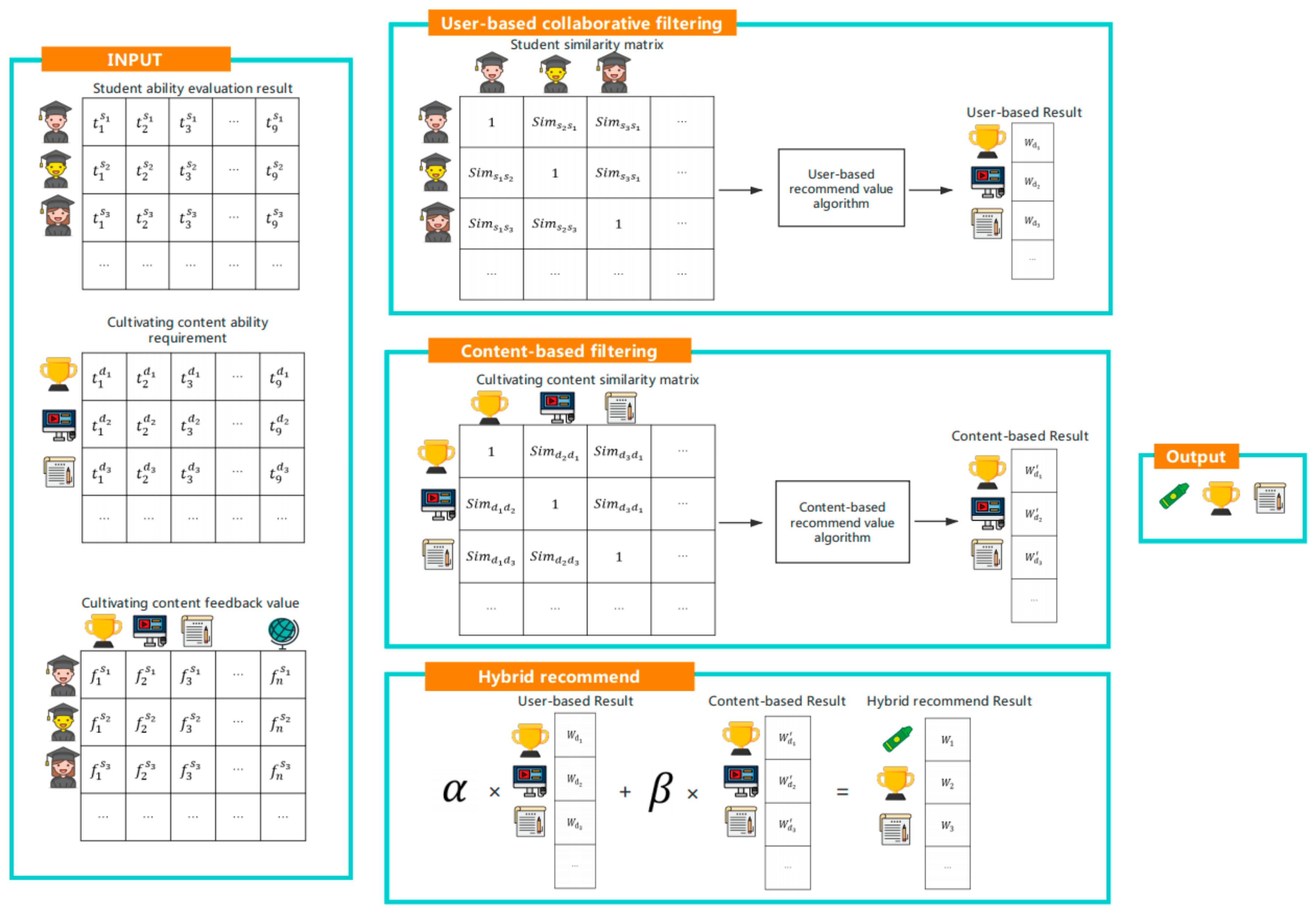

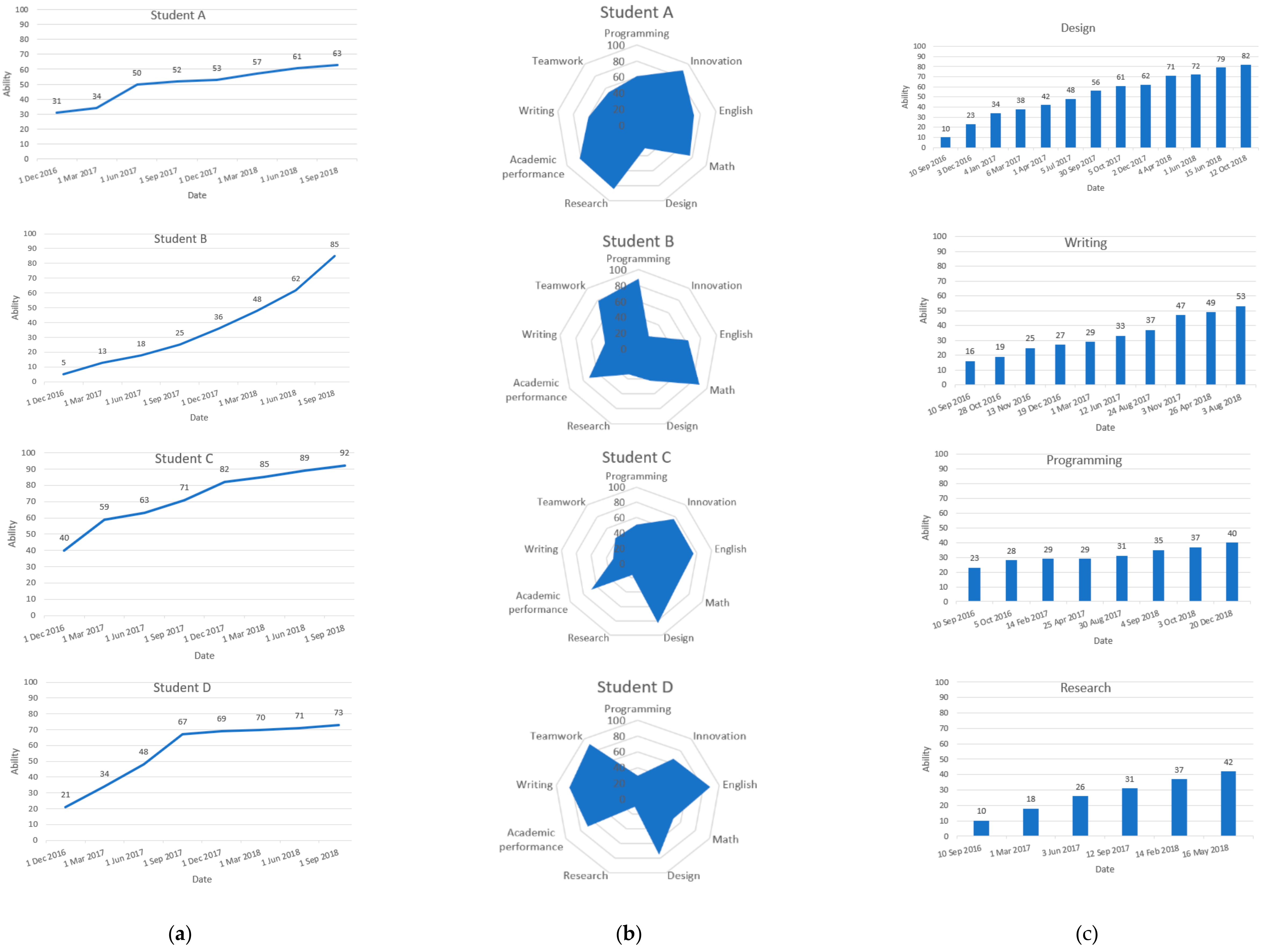


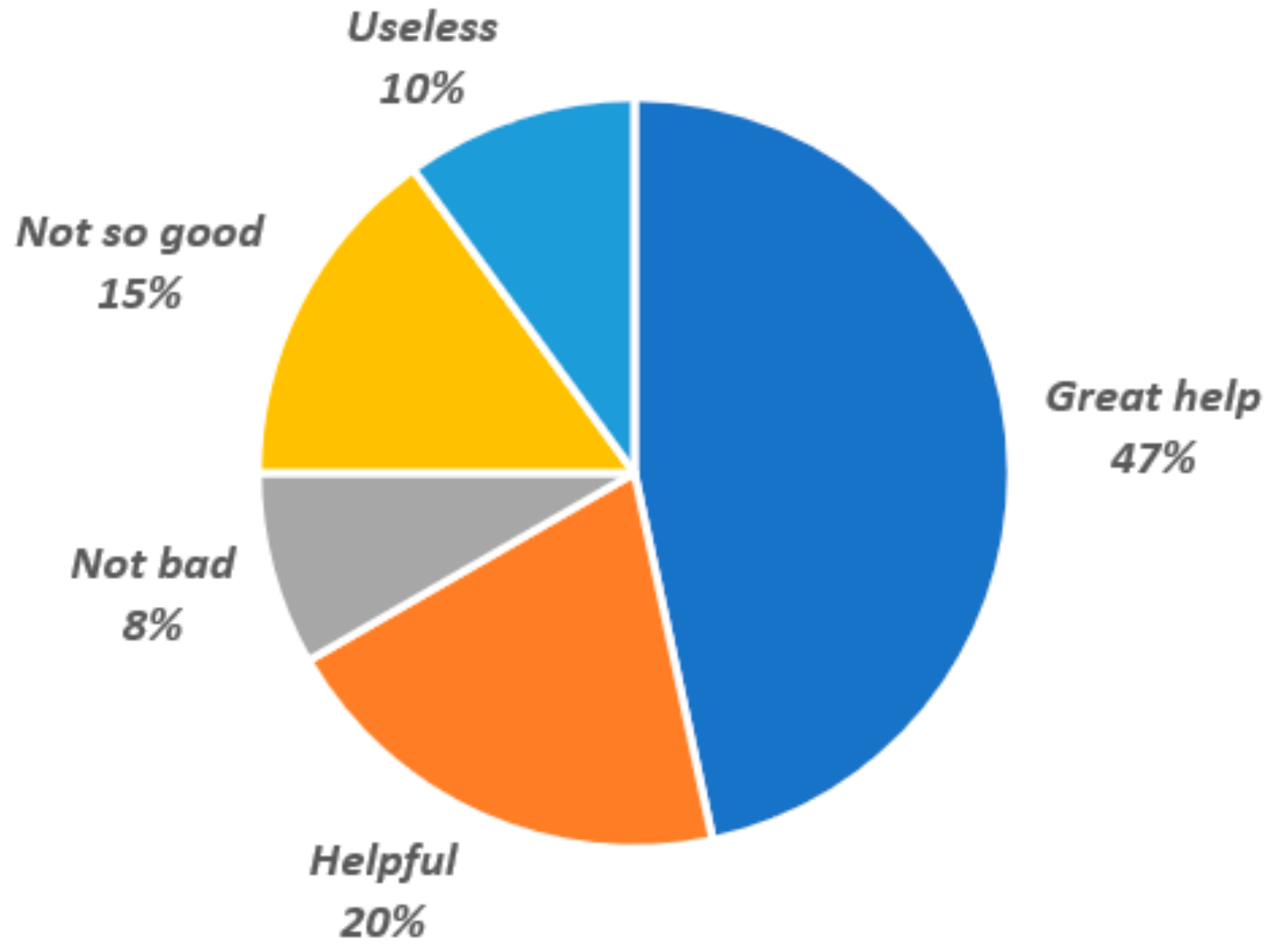
| Single Ability | Ability Description |
|---|---|
| Computer technology | Measures the performance of students in understanding and writing code |
| Design ability | Measures the ability of students to present in design thinking, multimedia design and implementation |
| English ability | Measures students’ English learning level and English application level |
| Mathematical ability | Measures the ability of students in basic mathematics and applied mathematics |
| Scientific research ability | Measures students’ interest, potential and objective strength in the direction of scientific research |
| Writing ability | Measures the ability of students in language organization, logical expression (focusing on technology) |
| Innovation ability | Measures student thinking creativity |
| Cooperation ability | Measures the awareness, ability, and results of students seeking to work with others in their studies and life |
| Academic performance | Measures the learning performance of students in basic school courses |
© 2019 by the authors. Licensee MDPI, Basel, Switzerland. This article is an open access article distributed under the terms and conditions of the Creative Commons Attribution (CC BY) license (http://creativecommons.org/licenses/by/4.0/).
Share and Cite
Xiao, X.; Qin, H.; Fu, H.; Zhang, C. Improving the Professional Level of Managers Through Individualized Recommendation to Enhance the Quality of Air Pollutant Management in China. Sustainability 2019, 11, 6094. https://doi.org/10.3390/su11216094
Xiao X, Qin H, Fu H, Zhang C. Improving the Professional Level of Managers Through Individualized Recommendation to Enhance the Quality of Air Pollutant Management in China. Sustainability. 2019; 11(21):6094. https://doi.org/10.3390/su11216094
Chicago/Turabian StyleXiao, Xia, Hanwen Qin, Huijuan Fu, and Chengde Zhang. 2019. "Improving the Professional Level of Managers Through Individualized Recommendation to Enhance the Quality of Air Pollutant Management in China" Sustainability 11, no. 21: 6094. https://doi.org/10.3390/su11216094
APA StyleXiao, X., Qin, H., Fu, H., & Zhang, C. (2019). Improving the Professional Level of Managers Through Individualized Recommendation to Enhance the Quality of Air Pollutant Management in China. Sustainability, 11(21), 6094. https://doi.org/10.3390/su11216094



